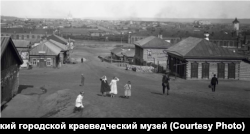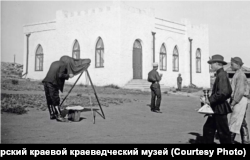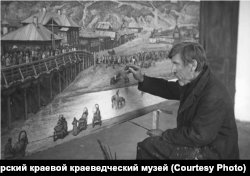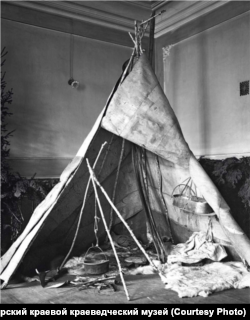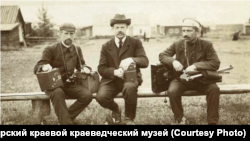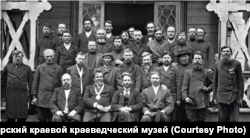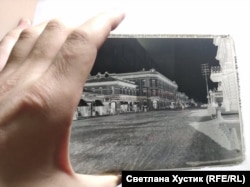The photograph above depicts a scene in the Siberian city of Krasnoyarsk in 1909, in which a man drives a cart pulled by...wolves! This original means of transportation went down in history forever thanks to photographer Ludwig Wonago (1872-1935), who at the beginning of the 20th century created a fascinating visual chronicle of life in the city 4,000 kilometers east of Moscow.
A collection of his photographs was kept largely in obscurity in the archives of the Krasnoyarsk Regional Museum of Local History for more than 80 years. But now a book dedicated to Wonago's work, Photographer On The Road, has been released. It contains 90 photographs taken from 1905 to 1933.
The collection of Wonago's photographs captures events such as the 1905 revolution, a devastating ice drift on the Yenisei River, city fires, and daily life in the Siberian city.
The subjects are captured on glass photographic plates. The quality of the images is so high that you can even see details on clothing worn by passersby.
The image below depicts the funeral of railway worker Mikhail Chalnikov in Krasnoyarsk. The procession stretches along a long wooden bridge over the Kacha River, and people carry wreaths and banners with revolutionary slogans. This is one of Wonago's earliest photographs, taken in 1905.
Chalnikov was killed by a police bullet during the dispersal of a workers' demonstration. His funeral turned into a new protest against the authorities, drawing more than 10,000 people. Wonago photographed the procession from multiple angles, as well as faces in the crowd and orators making speeches over the grave.
Thirty years later, Krasnoyarsk artist Dmitry Karatanov painted The Funeral Of Worker M. Chalnikov based on Wonago's photograph.
Another photo shows a shaman, Pyotr Sarlin, with a tambourine in his hand. Sarlin arrived in Krasnoyarsk to participate in an "ethnographic evening" held at the Pushkin City Theater in April 1910.
Shamanism was a fashionable topic at the time, and shamans toured cities, performing to full houses. On stage, Sarlin performed a shamanistic ritual, while in the foyer a real shaman's tent and a taiga hut were exhibited.
In 1913, the regional governor, Yakov Bologovsky, left Krasnoyarsk to move to a new position in Vologda. In the photo below, Bologovsky (center) bids farewell to the members of the local sokol gymnastics group that he had himself founded.
It's difficult to say what Wonago's political convictions really were. He appeared to document revolutionary workers' protests and patriotic demonstrations by the Union of the Russian People with equal enthusiasm. Most likely, he sought to capture everything that seemed important to him for the history of the city.
Wonago's's brother, Reinhold, served as a magistrate, but sympathized with the revolutionaries. Interior Minister Pyotr Stolypin even recommended that he be removed from his post due to his political convictions.
Instead, Reinhold went east, lived for some time in Vladivostok, and in the 1920s he returned to the family's original homeland, Poland.
Ilya Kuklinsky, the author and compiler of the book dedicated to Wonago, and Aleksandr Ulvert, its technical editor, told RFE/RL's Siberia.Realities about the photographer's unique collection.
"During our work, we managed to make a lot of personal discoveries. For example, we found a negative of Wonago's of a plaster sculpture of Napoleon. Now, this sculpture does not exist. Where it disappeared is unknown. A unique photo with a team of wolves in the city center. Of course, they didn't ride wolves in Siberia. This is a curious case, and we found a mention of it in the newspaper Krasnoyarets in 1909. There was an outraged article about how a man tortured the poor wolves," Kuklinsky said.
"We also found out that Wonago was the first sports photographer in Krasnoyarsk. The album contains his negative of a 1913 soccer match. At that time, it was quite difficult to take such a photo. To shoot a picture where everyone is running, you need a very fast shutter speed, a photosensitive plate, and sunny weather."
Forester And Photographer
Why is the photographer's legacy only now being brought to light?
Kuklinsky and Ulvert say that although the collection has been kept in the museum's archives since 1934, there was little information about Wonago himself.
"When I came to the museum 11 years ago, I almost immediately started working with the collection of photographs and negatives, including Wonago's. At that time, practically nothing had been sorted yet. But almost immediately there was an understanding that all this wealth must be published," Kuklinksy said. "The museum staff had tried to scan his negatives, but the technology of that time did not allow it to be done in high quality. Therefore, when the decision was made to publish the album, almost all the negatives had to be scanned again. At the same time, we began to collect information about the photographer himself."
Wonago was born in 1872 in Tomsk, where his father, who worked in the forestry administration of Kovno Governorate, in modern-day Lithuania, had been exiled in 1864 "for spreading harmful ideas." This came as the 1863-64 January Uprising in Poland and Lithuania against Russian rule was being crushed.
In 1902, Wonago was appointed a forest manager in the Yenisei region and moved to Krasnoyarsk. Reinhold had already moved to Krasnoyarsk. The first mention of Ludwig Wonago as a photographer is associated with the famous pillars of the Krasnoyarsk Stolby Nature Reserve, which he shot in 1901-02. Wonago photographed both the rocks themselves and the various methods of climbing them.
His position required constant travel, and, most likely, it was an excellent opportunity for a budding photographer. In November 1906, Wonago wrote a petition to the governor asking to open a "special workshop for enlarging portraits." He also wrote the governor asking permission to take photographs of the city, which was otherwise not permitted.
Having collected a certain stock of material, in 1908 Wonago issued two series of postcards with views of Krasnoyarsk and its environs. Even after his death, some of his photos of the pillars appeared on postcards, often without mentioning his name.
Toward the end of his life, Wonago left his forestry position and got a job first as a photographer at the Lake Shira resort, then at Lake Uchum. And in 1931 he began to work as a photographer at the State Museum of the Yenisei Region (now the Museum of Local History). Shortly before his death, he sold more than 400 of his glass negatives to the museum. Wonago died in 1935 at the age of 63 from multiple sclerosis. He is buried in the city cemetery.
More To Come
Properly scanning Wonago's negatives was one of the main challenges in completing the book. Ulvert said it was a difficult and painstaking task.
"Wonago photographed only on glass, although film appeared before the revolution," Ulvert told RFE/RL. "Wonago's negative is a 13-by-18-centimeter, glass bromo-gelatin plate. When scanned with a good scanner, it offers a myriad of possibilities. You can take a great photo, even print a banner if you want. This allowed us to build the book according to the focal-points principle, where on one page the entire photo is displayed, and on the next are pieces of it. They're often so clear that you can identify a person, count the buttons on his clothes."
"A similar result could also be achieved from the film negative of that time. But with perforated film, on which they began to shoot in the middle of the 20th century, it is unlikely. In terms of quality, modern digital technologies are only catching up with the negatives of that time," Ulvert explained.
More than 700 of Wonago's glass negatives are kept in the archives of the Krasnoyarsk Regional Museum of Local History. The new book includes only 90, which mainly depict Krasnoyarsk, even though Wonago also photographed outside the city.
Hundreds of his negatives have yet to be released, and a second volume of his photographs is expected soon.






